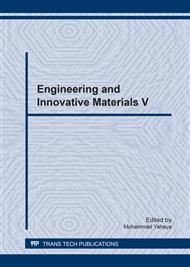[1]
S. Miyazaki, H. Kim and H. Hosoda: Development and characterization of Ni-free Ti-base shape memory and superelastic alloys. Materials Science and Engineering: A(2006) 438: pp.18-24.
DOI: 10.1016/j.msea.2006.02.054
Google Scholar
[2]
Y. Wang and S. Dai: Structural basis of metal hypersensitivity. Immunologic Research (2013) 55(1-3): pp.83-90.
Google Scholar
[3]
S. Dubinskiy, Ti-Nb-(Zr, Ta) superelastic alloys for medical implants: thermomechanical processing, structure, phase transformations and functional properties. (2013) Superior Technology School.
Google Scholar
[4]
H.Y. Kim, et al., Crystal Structure, Transformation Strain, and Superelastic Property of Ti–Nb–Zr and Ti–Nb–Ta Alloys. Shape Memory and Superelasticity. Shape memory and Superelasticity (2015) 1(2): pp.107-116.
DOI: 10.1007/s40830-015-0022-3
Google Scholar
[5]
D. Kurod, et al., Design and mechanical properties of new β type titanium alloys for implant materials. Materials Science and Engineering: A (1998) 243(1): pp.244-249.
DOI: 10.1016/s0921-5093(97)00808-3
Google Scholar
[6]
N. Sakaguchi, et al., Relationships between tensile deformation behavior and microstructure in Ti–Nb–Ta–Zr system alloys. Materials Science and Engineering: C (2005) 25(3): pp.363-369.
DOI: 10.1016/j.msec.2004.12.014
Google Scholar
[7]
M. Tane, et al., ω Transformation in cold-worked Ti–Nb–Ta–Zr–O alloys with low body-centered cubic phase stability and its correlation with their elastic properties. Acta Materialia: (2013). 61(1): pp.139-150.
DOI: 10.1016/j.actamat.2012.09.041
Google Scholar
[8]
S. Dubinskiy, et al., In situ X-ray diffraction strain-controlled study of Ti–Nb–Zr and Ti–Nb–Ta shape memory alloys: crystal lattice and transformation features. Materials Characterization (2014) 88: pp.127-142.
DOI: 10.1016/j.matchar.2013.12.008
Google Scholar
[9]
H. Y. Kim, et al., Mechanical properties and shape memory behavior of Ti-Nb alloys. Materials Transactions. 45(7): pp.2443-2448.
Google Scholar
[10]
R. Kainuma, et al., Invar-type effect induced by cold-rolling deformation in shape memory alloys. Applied physics letters: (2002) 80(23): pp.4348-4350.
DOI: 10.1063/1.1485118
Google Scholar
[11]
M. Abdel-Hady, K. Hinoshita, and M. Morinaga, General approach to phase stability and elastic properties of β-type Ti-alloys using electronic parameters. Scripta Materialia: (2006) 55(5): pp.477-480.
DOI: 10.1016/j.scriptamat.2006.04.022
Google Scholar
[12]
M. Abdel-Hady and M. Morinaga, Controlling the thermal expansion of Ti alloys. International Journal of Modern Physics B: (2009) 23(06n07): pp.1559-1565.
Google Scholar
[13]
M.A.H. Gepreel, New Ti-alloy with negative and zero thermal expansion coefficients. Key Engineering Materials: (2012) 495: pp.62-66.
DOI: 10.4028/www.scientific.net/kem.495.62
Google Scholar


